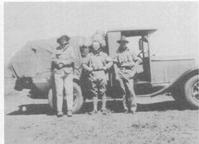


Flyleaf
Online Edition
Title Page
Imprint
Message
Tribute
Foreword
Table of Contents
Contributors
Sir Lindesay Clark
Introduction
Index
Search
Help
Contact us

'For a while I did very well, I think much better than most of my contemporaries but it was a chancey sort of business -that is financially -and when the Depression came the sort of work I was doing was looking at new mines, prospecting and development, and that ceased.'
In his own business, work fed to him by his father was helpful. One such project was passed on to him in 1930, when the noted Australian mining entrepreneur W. S. Robinson who foresaw a rise in gold price asked Clark Senior to report on a property in Tasmania. Not wanting to do the job himself, he passed it on to his son. The examination and report so impressed 'W. S.' that he later offered 'young Clark' a job as a mining engineer in his newly formed company. Gold Mines of Australia Ltd.
'He'd been thinking of somebody for Gold Mines of Australia I imagine -you know someone to run it -and so he offered me a job. It wasn't very well defined what it was, but I soon became the Manager. There were about three men and a dog in the organisation at the time, but it gradually built up. And that's how I went into Collins House.'

Lindesay Clark became Manager of Gold Mines of Australia Ltd. in 1931 and Technical Managing Director of Western Mining Corporation Ltd. on its formation in 1933. By the outbreak of the Second World War the GMA-WMC Group under Clark's direction had examined hundreds of prospects, from which ten productive gold mining operations resulted -six in Western Australia, three in Victoria and one in Queensland -usually as newly formed associated companies including Mt. Coolon Gold Mines N.L., Gold Mines of Kalgoorlie Ltd., Central Norseman Gold Corporation N.L., Triton Gold Mines N.L., Morning Star (GMA) Mines Ltd., and Victoria Gold Dredging Co. N.L.
His perseverance with gold exploration in fields that had been deserted by many others, his courage and scientific approach to their development and his very sound handling of the social responsibilities involved, contributed much to the settlement of the more difficult regions of this country. Mount Coolon, inland from Bowen, in Queensland, was the first mine in the Group to begin production. Although it was limited in extent, it provided income to support an exploration program elsewhere.
During these years, Lindesay Clark worked closely under the direction of Sir Colin Fraser, Sir Arthur Robinson, W S. Robinson and later Sir Walter Massy-Greene, from all of whom he acknowledged having learnt a great deal. 'W.S.', he once said, 'was a witty and imaginative man with broad sympathies with his fellow man, and no one could work with him without benefitting from the experience.' The others 'were very good listeners, (and) to have come under the influence of these men, as well as (his) father, was a very fortunate thing for a young man'.
Lindesay Clark's enthusiasm for a scientific approach to exploration was evident in the 1930s when WMC engaged a team of eminent Harvard geologists under Dr. Hugh McKinstry to do a thorough assessment of prospective areas, when very few mines even employed a full time geologist. Another innovative activity in which he took part was an aerial survey of 26,000 square kilometres of the Eastern Goldfields of Western Australia.
Organisations in Australian Science at Work - Gold Mines of Australia Ltd; Mount Coolon Gold Mines N.L.; Western Mining Corporation
People in Bright Sparcs - Robinson, W. S.
 |
Australian Academy of Technological Sciences and Engineering |  |
© 1988 Print Edition pages xvi - xvii, Online Edition 2000
Published by Australian Science and Technology Heritage Centre, using the Web Academic Resource Publisher
http://www.austehc.unimelb.edu.au/tia/xiii.html